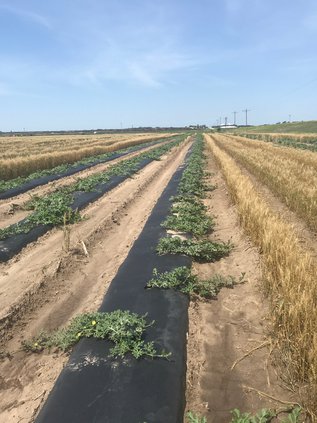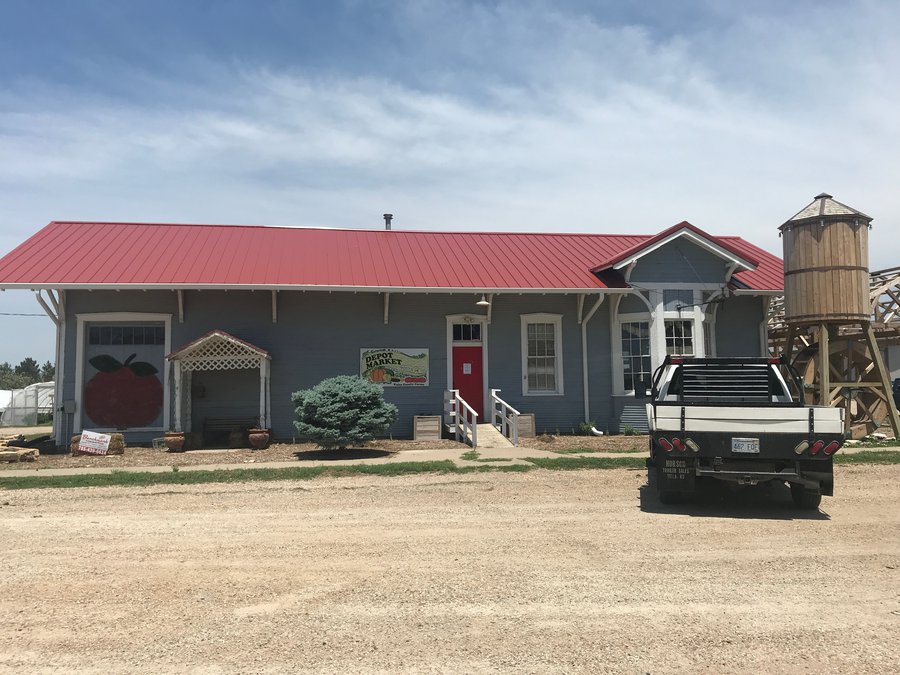Most specialty crop operations in Kansas rely heavily on direct-to-consumer sales. While several farmers are specializing and scaling to provide to institutional and wholesale purchasers, one of the largest and to-date most successful is Depot Market in Courtland, run by Dan Kuhn and his wife, Kathy. Currently, the farm’s sales are nearly 80 percent to wholesale outlets. But that’s not how Kuhn got started and isn’t where he intends to keep growing.
Kuhn wanted to be a farmer, “but I was raised as a city kid in Shawnee. After attending KU, I went to K-State and farmed some orchards nearby. When I graduated, I had an opportunity to work on an orchard north of Courtland, so I moved here and started working for that orchard, then started farming for myself,” Kuhn says. In 1989, he and his wife bought 1.5 acres and the old Santa Fe Depot in Courtland, renovated it, and moved it to the property alongside Highway 36, where it still sits today. The site houses a retail store, vegetable washing/packing house and walk-in cooler (added in 2010), and is a convenient location for deliveries and pickups.
“We started with apples, including you-pick, all through the ’80s, but moved away from them toward vegetables as the market shifted. We raised seven kids and lived below poverty level for a long time. My wife did some teaching and for a few winters I worked at a meat-packing plant to pay bills,” Kuhn says. The family relied on borrowing from the bank when needed and organic growth to scale. “I didn’t start with anything. I had no land and wasn’t from here. In 1981, my grandmother died and left me $12,000. We probably wouldn’t have made it without that.”
It was clear on the day KRC visited that Kuhn has come a long way since the start. We walked through the washing and processing house as a truckload of freshly picked zucchini was packed and sent off for delivery. “We sell in 10 states on average each year, and pumpkins are our biggest crop. Two large chains comprised half of our total sales,” Kuhn says. “We also sell to our local guys and local peddlers and would like to grow that business, but we can’t make a dead switch and keep the farm. If we could, we’d like to have a route going through western Kansas and hit a loop to sell to those smaller markets.”
To sell at such a scale requires growing at a large scale, hiring at a large scale and dealing with a large amount of paperwork. Kuhn has 190 acres under production, and his largest pumpkin and watermelon fields, each 50-plus acres, are planted under center pivot. Kuhn manages 29 employees during pumpkin time, which grows from 12 employees earlier in the season. Two employees work full-time, year-round. In the first week of June, eight H-2A program workers were employed on the farm, living in provided housing. (The H-2A Temporary Agricultural Workers program, sometimes referred to as “visa hiring program,” allows U.S. employers who meet specific regulatory requirements, including housing, to bring foreign nationals to the U.S. to fill temporary agricultural jobs.)
“The number of visa hire will increase as the season progresses. This is our 11th year hiring through the visa hiring program. We don’t really have other farmers nearby who hire through the program,” Kuhn says.
The farm is compliant with Good Agricultural Practices (GAP) and Food Safety Modernization Act (FSMA). GAP, required by many chains to sell into their stores, is a voluntary audit that verifies that fruits and vegetables are produced, packed, handled, and stored in adherence to the recommendations made in the U.S. Food and Drug Administration’s (FDA) Guide to Minimize Microbial Food Safety Hazards for Fresh Fruits and Vegetables. FSMA is a separate voluntary certification overseen by the FDA, which includes a specific set of on-farm practices that must be met. By January 27, 2020, any farm where the average annual monetary value of produce the farm sold during the previous 3-year period is more than $25,000, will be required to be compliant.
“We had started selling to bigger wholesale customers who required us to get GAP certification in order to keep them as a customer,” Kuhn says. The certification is managed by one of Kuhn’s full-time employees, who also oversees bringing in a GAP auditor. This year the auditor came from Texas, so the farm pays for travel and lodging expenses on top of its certification fees each year to maintain certification and its wholesale clients. Other years the auditors have come from Kansas City, Mo. Some of the tracking requirements include a sign-in for handwashing outside of the walk-in cooler and portable bathrooms and handwashing in the fields. Currently, GAP and FSMA are not aligned on the requirements, each with its own processes and bookkeeping stipulations.
To accommodate orders by the semi-truckload, Kuhn and his team manage 12 hoop houses, the majority filled with tomatoes: “about five varieties, one house has indeterminants.” (Indeterminate tomato varieties tend to have a longer fruiting season but their fast, continuous growth habit requires trellising and pruning in a hoop house setting.) One of the hoop houses is filled with raspberries (“a great retail crop through frost”), and one with cucumbers (“as profitable as the tomatoes”).
“We have our hoop houses located in a spot with some wind protection, which is key for this part of the state. For us, the bigger the house, the better. We put removable ends on them so we could run a tractor and farm straight through,” Kuhn says.
His watermelon field is planted with rows of wheat between the rows of melons to operate as windbreaks. The weeds are kept down with herbicides, a pre-emergent and then post-emergent applied with a shielded sprayer. For the pumpkins, “We have been working on a no-till program. Two years ago, our cover crop didn’t burn down fully and the pumpkins came up with weeds. We probably spent $40,000 hoeing them free, with as many as 18 hoes swinging at a time. The pre-emergent timing is key to preventing that sort of disaster.”
Kuhn’s fields are nestled among conventional row crops, but he hasn’t yet experienced damage from spray drift. “We haven’t been hit with drift yet, but it scares me. A group of specialty crop growers in our area, including us, put an ad in the paper about how the use of Dicamba can destroy our crops and our income,” Kuhn says. “The loss of one of our fields of pumpkins would be devastating, so especially with Dicamba, we’re nervous. We have crop insurance, but it doesn’t cover loss to spray drift.”
Kuhn says he doesn’t plan to keep growing the operation. “We are trying to switch to play smaller ball, and sell more locally and on farm.” He has his reasons. “Up until this year, we were paid a premium for being local by most of our larger wholesale customers. They ended that this year. While their marketing is local and organic everywhere, they are pulling away from local farmers, even those of us they have worked with for years,” Kuhn says. “On top of that, they make a lot of demands of us farmers, such as needing us to be in their bookkeeping systems. We pay to be in their systems. This is an additional revenue stream for them. That on top of the GAP certification makes it expensive to continue to work with them.”
The consolidation of the larger chain warehouses has not been kind to grocery stores in western, rural Kansas. “Dillons, AWG and Wal-Mart are the main outlets and their warehouses have been consolidated over the last five years. West of us, they only have one warehouse. They’re in a bad way. If you could make a delivery route work, then you could have fresh produce in the smaller grocery stores to keep customers excited and keep those smaller stores open. It will only get worse as it consolidates,” Kuhn says.
Some changes are happening to help make the transition to being smaller and more local again. The farm has brought on Mark Stadler, who is a full-time farm manager helping make some of these transitions. This year is the first year the farm is trying trellised thornless Natchez blackberries. They planted 300 bushes, the first farm in North Central Kansas to try this method of growing for a you-pick target market. The farm also planted 8 acres of asparagus intended for retail markets.
These types of innovations are not readily available in education materials for growers across the state, however; a fact not lost on the Kuhns and Stadler. “We want to teach others how to do specialty crops and teach some of the topics where extension used to be in operation,” Kuhn says. “When I was a student at K-State, I studied apples under a full-time pomologist. Students today don’t have that opportunity. Today, the extension specialist Cary Rivard is one of the only resources people know of to turn to, and he’s great, but the needs extend beyond his capacity. We need to bring more people in to share expertise, especially in the western half of the state.”
After visiting with Kuhn, it feels that the specialty-crop market is gearing up for some big changes and big decisions. What is the type of market people want to access, and what type of farmers do growers want to be? Navigating the waters of wholesale versus smaller, localized markets—and establishing the proper distribution channels and fair regulations—will play a key role, along with creating the path for farmers to learn new techniques and connect with peers to make the (likely) necessary changes to build a sustainable, ecologically diverse food and farming system.
Jennifer Kongs is a freelance writer with Bark Media in Lawrence who produced this story as part of KRC’s Specialty Crop Block Grant funded by the Kansas Department of Agriculture through USDA’s SCBG Program.









